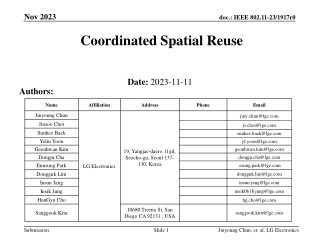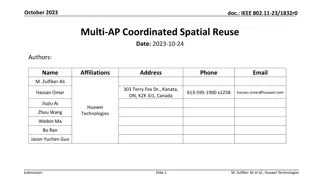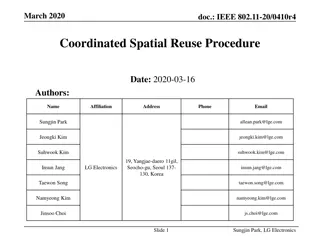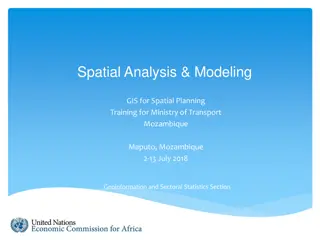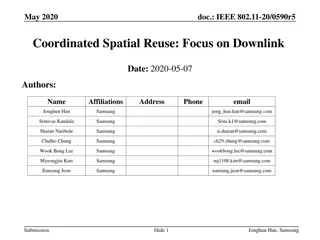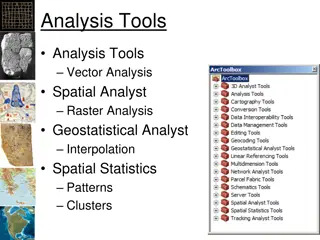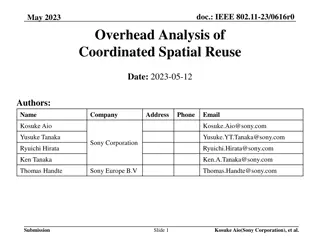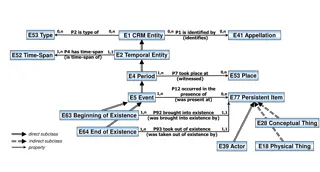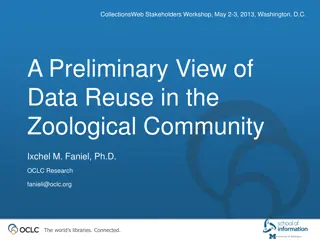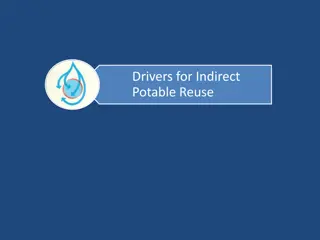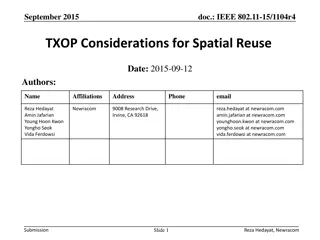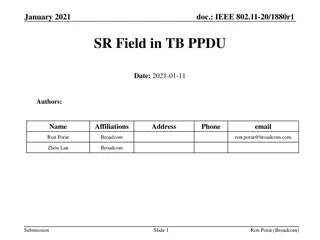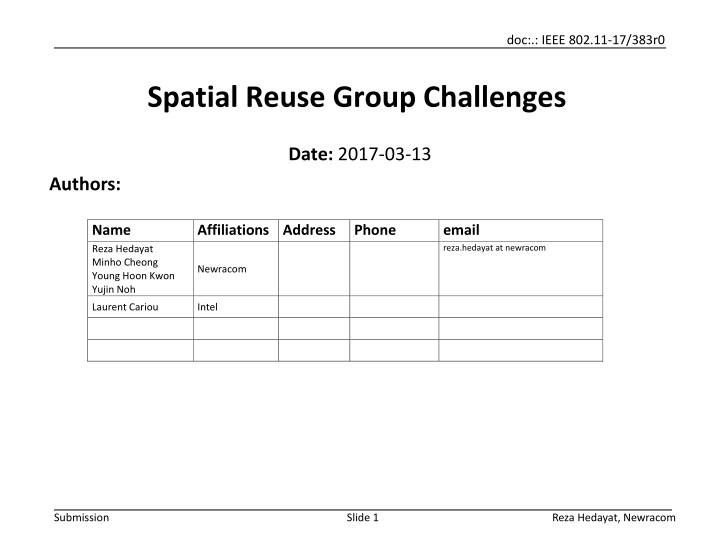
IEEE 802.11-17 Spatial Reuse Group Challenges
Explore challenges related to Spatial Reuse Groups (SRG) in the IEEE 802.11-17 standard. Learn about OBSS-PD rules, SRG formation, unintended behaviors, and the impact on interference and collision in wireless network environments.
Download Presentation

Please find below an Image/Link to download the presentation.
The content on the website is provided AS IS for your information and personal use only. It may not be sold, licensed, or shared on other websites without obtaining consent from the author. If you encounter any issues during the download, it is possible that the publisher has removed the file from their server.
You are allowed to download the files provided on this website for personal or commercial use, subject to the condition that they are used lawfully. All files are the property of their respective owners.
The content on the website is provided AS IS for your information and personal use only. It may not be sold, licensed, or shared on other websites without obtaining consent from the author.
E N D
Presentation Transcript
doc:.: IEEE 802.11-17/383r0 Spatial Reuse Group Challenges Date: 2017-03-13 Authors: Name Reza Hedayat Minho Cheong Young Hoon Kwon Yujin Noh Affiliations Address Phone email reza.hedayat at newracom Newracom Laurent Cariou Intel Submission Slide 1 Reza Hedayat, Newracom
doc:.: IEEE 802.11-17/383r0 Background: OBSS-PD Rule OBSS-PD rule Given an OBSS-PD range (OBSS-PD-min/max) announced by an AP, the associated STAs can ignore any OBSS PPDU that has RSSI less than OBSS-PD-min Spatial reuse group (SRG) A set of AP/BSS together form a SRG group so that each BSS would apply potentially more aggressive OBSS-PD-min/max to any other OBSS PPDU originated from other BSS within the SRG Given above rules, it is possible that SR STAs apply aggressive OBSS-PD thresholds to OBSS PPDUs causing increasing level of interference and more collision Submission Slide 2
doc:.: IEEE 802.11-17/383r0 Spatial Reuse Group (SRG) [16/947r21] Example: AP1/2/3 form a SRG AP1/BSS1 with Color C1 AP2/BSS2 with Color C2 AP3/BSS3 with Color C3 STAs in BSS1 use a more aggressive OBSS-PD-min/max for OBSS PPDUs with Color C2, C3 (SRG OBSSPD-MIN/MAX) Similarly STAs in BSS2/3 Example: SRG OBSSPD-MIN = -62dBm STAs in BSS1/2/3 use modified NON-SRG OBSS-PD for other OBSS PPDU Example: NON-SRG OBSSPD-MIN = -82dBm BSS2, Color C2 AP2 AP1 AP3 BSS3, Color C3 BSS1, Color C1 Submission Slide 3
doc:.: IEEE 802.11-17/383r0 What Could Go Wrong? Consider presence of an OBSS that doesn t belong to the SRG BSS0/AP0 with Color C0 If C0 is different than C1/2/3 Then SRG STAs use the intended OBSS-PD: NON-SRG OBSSPD But if C0=C3, STAs in BSS1/2 treat BSS0 PPDUs with SRG OBSS-PD thresholds (SRG OBSSPD-MIN) This is an unintended behavior from SRG STAs Chance of this happening is: the size of SRG divided by 64 E.g. if SRG has 16 BSS, the chance of collision is 0.25 BSS2, Color C2 BSS0, Color C0 AP0 AP2 AP1 AP3 BSS3, Color C3 BSS1, Color C1 Submission Slide 4
doc:.: IEEE 802.11-17/383r0 What Could Go Wrong? Similar unintended behavior could happen between two SRGs as well In a public place e.g. airport, there could be two or more WiFi providers, each forming own SRG. In this example, if C21=C11: Within BSS22 coverage, BSS11 PPDUs get treated with SRG2 OBSSPD-min Within BS12 coverage, BSS21 PPDUs get treated with SRG1 OBSSPD-min If SRG OBSSPD-min=-62dBm in both SRG, then BSS21 and BSS11 more interference/collision, which would have not existed without SRG SRG2, BSS21 Color C21 SRG1,BSS12 Color C12 SRG2,BSS22 Color C22 SRG1, BSS11 Color C11 Submission Slide 5
doc:.: IEEE 802.11-17/383r0 Challenges with SRG Rules The intention of SRG proposal is that a set of APs are grouped together by a higher entity that controls the operation of APs Operations such as channel and BSS Color selection of the APs However, there is no guarantee that an AP announces SR Parameter set with the right APs/Colors; and IEEE spec and certification programs are blind about it Example of using SRG to be aggressive in using medium: An unmanaged AP may announce an SRG and list several random BSS Colors within its SR Parameter Set and set an aggressive SRG OBSS-PD As a result, STAs associated with the AP follow the AP announcement and treat all OBSS PPDUs with the aggressive SRG OBSS-PD thresholds Submission Slide 6
doc:.: IEEE 802.11-17/383r0 Challenges with SRG Rules Applying aggressive SRG OBSS-PD thresholds to non-SRG OBSS causes additional interference and collisions to the non-SRG OBSS Note that -82dBm SRG OBSS-PD -62dBm, hence practically it is possible that the difference in SRG and NON- SRG OBSS-PDs be as large as 20dB For instance: BSS0, the non-SRG BSS in slide 4, could be using PD=- 82dBm while the SRG BSS use OBSS-PD-min=-72dBm or -62dBm Submission Slide 7
doc:.: IEEE 802.11-17/383r0 Possible Solution - 1 To help uniquely identifying SRG PPDUs, one solution is to add a new identifier SRG ID (or ESS Color) in each SRG PPDU, which is best if it is in HE SIG-A Solution: SRG Identifier Assign a multiple-bit subfields in HE SIG-A to indicate a SRG ID Pros: Easiest way in identifying SRG PPDUs Most robust solution Cons: Need allocation of several bits within HE SIG-A Submission Slide 8
doc:.: IEEE 802.11-17/383r0 Possible Solution - 2 Alternatively, in order to let a STA to find out whether a PPDU is a SRG PPDU or not, one can indicate such PPDUs with a single bit in HE SIG-A Solution: SRG Indication Assign a single bit in HE SIG-A to identify SRG PPDUs Pros: Carrying a SRG indication in SIG-A offers an easy way in identifying SRG vs non-SRG PPDUs Cons: It does not resolve the problem when there are two SRGs (slide 5) Need allocation of a bit within HE SIG-A Submission Slide 9
doc:.: IEEE 802.11-17/383r0 Possible Solution - 3 Each SRG AP actively monitors the potential non-SRG OBSS and finds out if exists a collision between the OBSS color and the BSS colors in SR Parameter Set, removes the BSS Color from the list and resends the SR Parameter Set to its STAs Solution: AP identifies potential SRG BSS Color collision and removes each instance of BSS Color collision and resend SR Parameter Set Pros: It rests the responsibility of identifying such Color Collision on the AP that wants to take advantage of SRG Cons: It does not resolve the problem when the collision happens at the edge of coverage (when AP cannot detect it) Slide 10 Submission
doc:.: IEEE 802.11-17/383r0 Possible Solution - 4 Solution: Let each SRG STA identify potential Color Collision SR Parameter Set need to include: BSS Color (that is part of the SRG) as well as the BSSID that is associated with the BSS Color An SRG STA identifies a SRG PPDU by making sure that both BSS Color and the associated BSSID matches the associated fields within a potential SRG PPDU Pros: Resolves the problem robustly Cons: Complicates the SRG operation because it requires a SRG STA to match BSS Color (from SIG-A) and BSSID (from PPDU MAC header) to find out whether a PPDU is a SRG PPDU Submission Slide 11
doc:.: IEEE 802.11-17/383r0 Conclusion There is a possibility that a SRG STA treats a non-SRG PPDU with SRG OBSS-PD thresholds instead of NON-SRG OBSS-PD This is an unintended consequence of SRG rules This could cause a non-SRG STA be unfairly treated by as large as 20dB in preamble-detect difference This could affect a unmanaged OBSS, and could affect managed OBSS that is happen to be part of another SRG Several possible solutions are offered in this contribution to resolve this type of color collision Submission Slide 12

